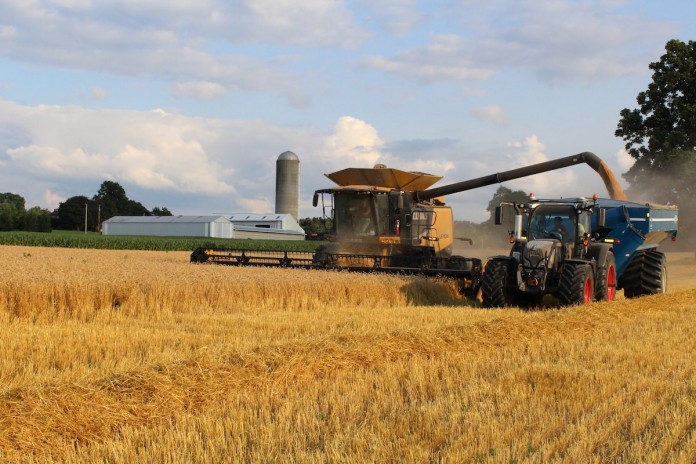SALEM, Ohio — The question for many farmers is: Should we or shouldn’t we?
Wheat
With this year’s wheat harvest about two-three weeks behind normal, farmers must now gamble over whether to plant a second, “double crop.”
Ralph Wince,a grain merchandiser with Agland Co-Op, said he estimates that 90 percent of the wheat harvest in the area is complete.
Wince said that some farmers who are still harvesting wheat will probably have it done within a day or two. He said there has been very little reports of Vomitoxin in the wheat that has been spot checked at Agland.
“Overall, it hasn’t been too bad,” said Wince.
Double crops
A double crop of soybeans can add a lot of value to the field, but only if it has time to mature before the first hard freeze.
Bob Baugher, of Baugher Farms in Trumbull County, said he rarely plants a double crop, even in a normal year.
“We don’t plant anything if we can’t get a good harvest on it,” he said.
While he won’t be double-cropping, he did get a good yield for his wheat, at just under 100 bushels per acre. And the amount of straw, he said, has been “tremendous.”
Other farmers are taking their chances and planting the double cropping, keeping their fingers crossed that winter will be late.
Wild card
Farmers in northwestern Ohio, for example, were able to harvest wheat much earlier. Still, it all comes down to what the weather does this fall.
“Whatever mother nature decides to do this fall will be the question,” said Tina Lust, a certified crop advisor with Beck’s Hybrids and NuTech Seed.
Lust said she lets farmers make their own decisions about whether another crop is worth the effort, but many are still going for it, with some considering other double crops, like cover crops.
She advises farmers in north central Ohio counties. If nothing else, the second crop will at least cover the ground, and offer all of the positive benefits of cover crops.
If fall is normal or late this year, things could still be OK.
“We just don’t know this year,” Lust said. “It’s been a crazy year.”
Wince feels much the same way about the soybean and corn crops.
He said that many corn fields are still uneven.
“Pockets of things look horrible. Some look good. A lot of them are in between,” said Wince.
Corn crops
He is quick to point out that at least they look better than a month ago.
Wince added that the corn crop does appear to be lagging behind in maturity with some in tassel and some trying to catch up in height. He said there is no doubt that the cooler temperatures this summer and wet weather has changed how corn grows in the fields.
One thing Wince views as very possible this corn harvest is setting a new national yield record. He said that it is ranking between 76-80 percent in good to excellent condition, which is way above the five-year average of 58 percent.
“The record set a few years ago was around 165 million bushels and it’s hard to think we won’t break it with the way the corn crop conditions are across the country,” said Wince.
He pointed out that Illinois farmers have reported that 81 percent of the corn crop is rated in good to excellent condition and in Iowa farmers are rating theirs around 77 percent, which will all contribute to the national yield if the weather patterns continue.
In Ohio, the National Agricultural Statistics Service reported that most areas have benefited from the dry weather, though a few regions noted stressed crops as the ground is drying out. Corn silking is slightly behind 2013 and the five year average, according to the report.
And in Pennsylvania, the NASS reported that the average height of emerged corn is 60 inches and some corn has just begun the milk phase. Winter wheat is almost all mature in the state.
Soybeans
Wince said the month of August will determine how the soybean crop turns out in northeast Ohio. However, as of now, soybeans are ranking good to excellent across the area. He said that in Ohio, 73 percent of the soybean crops are ranking between good and excellent, which is way above the 58 percent five-year average.
Wince said even with the corn crops in northeast Ohio being uneven, the crops don’t appear to be running towards a disaster for northeast Ohio.
“But its not where we were at two or three years ago either,” said Wince as described the drought in Illinois two years ago but the abundant crops farmers in northeast Ohio experienced.
According to the NASS report in Ohio, the soybean bloom is behind compared to last year and the five year average; however more soybeans are setting pods compared to this time in 2013. Producers have been in fields this week spreading lime and spraying soybeans to keep weeds at bay.
In Pennsylvania, the NASS report states that soybeans pods have just begun to set.
The NASS report also said even with the rainfall, some farmers in Ohio and Pennsylvania are actually making their third cutting of hay. It is quick to point out, though, that most farmers are just finishing up their first cutting due to the wet rainy conditions in June and so far this month.
Some farmers have begun their third cutting of alfalfa while most are just finishing up their first cutting.
STAY INFORMED. SIGN UP!
Up-to-date agriculture news in your inbox!











